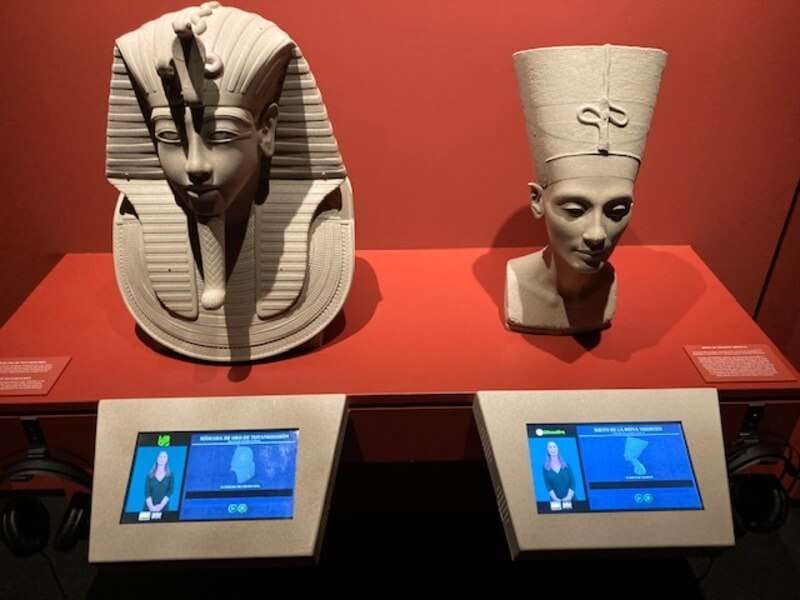Daughters of the Nile, the great role of women in ancient Egypt

More than 300 pieces, on loan from 27 museums, foundations and public and private institutions from 12 countries, make up a truly fascinating exhibition. It is the one on display at the Palacio de las Alhajas in Madrid under the title "Daughters of the Nile". Women and society in ancient Egypt. An exhibition conceived and produced by Eulen Art, the business line of the Eulen Group specialising in the comprehensive management of artistic and cultural heritage.
The exhibition thus joins the numerous ephemeris of Egyptology that follow one another: one hundred years since the discovery of the tomb of Tutankhamun by Howard Carter; two hundred years since the deciphering of the Rosetta Stone by Jean-François Champollion, and fifty years since the inauguration of the Temple of Debod in Madrid, which Egypt donated to Spain in gratitude for our help in the salvage and transfer of Abu Simbel so that it would not be flooded by the waters of the gigantic Aswan dam.

Curated by the Barcelona-born Esther Pons, head curator of the Department of Egyptian Antiquities at the National Archaeological Museum, and by the historian, disseminator and Egyptologist from León, Nacho Ares, the exhibition focuses exclusively on the important role played by women in ancient Egypt. In fact, they enjoyed an independence unknown in other contemporary and even later cultures. "This reality, so accepted in today's societies, already existed 48 centuries ago", says María José Álvarez Mezquiriz, the current president of the Eulen Group, who also pays tribute to her father, David Álvarez, who sixty years ago set up a business conglomerate that today employs more than 90,000 people. 
Many of the star pieces in the exhibition have never before been shown in Spain, and cover a very long period of time, more than 3,500 years, during which the social, economic and religious structure evolved over a vast territory.
It is true that it was in the better-off social classes that women's independence and freedom were most clearly seen, but what is undeniable, according to the curators of the exhibition, is that men and women were equal before the law. Women were men's companions, their complementary. A concept far removed, for example, from that which existed in Greek society, where women were considered to be minors.

Sculptures, reliefs, documents, everyday objects, numismatic pieces, domestic utensils, musical instruments, jewellery, objects for religious and funerary use, are framed by life-size reproductions of funerary chambers, such as the tomb of Sennejdem, typhlological pieces and immersive audiovisuals, including a striking recreation of the funerary chamber of Nefertari (1279-1255 BC).
The four main areas of the exhibition itinerary show what life was like for women in the Pharaonic period and in the Ptolemaic-Roman period, covering all social strata, from the humblest women, such as peasant women, to the highborn ladies of the court. And, above all, it highlights, in addition to family life, the plurality of trades and positions they held and the legal and religious bases that made the status of women equal to that of men. Ruling queens such as Tiyi, Hatshepsut, Nefertiti, Nefertari and Cleopatra VII, as well as those who were royal wives, princesses, mothers, mothers-in-law and sisters of the pharaoh, highlight the great power that women wielded at court.

The role played by women in the religion of ancient Egypt is no less important. The exhibition unravels the keys to the complex and difficult world of religious beliefs in the land of the Nile, where there was always a place for priestesses, worshippers of Amun, dancers and caretakers of the temples. And, of course, the female divinities, such as Hathor, Bastet, Sekhmet and Tueris, and especially Isis, who, revered as a heavenly mother, would become over time the most important goddess in Egyptian mythology. Her influence would spread to the religions of different civilisations, where her cult would become consolidated, especially throughout the Roman Empire.

The current events have revitalised Egyptomania, which came into vogue in Europe at the end of the 18th century, when Napoleon Bonaparte entered Egypt in 1798, and was decisively boosted by the discovery of the tomb of the young pharaoh Tutankhamun on 4 November 1922 by Howard Carter and his patron Lord Carnavon. The exhibition also pays tribute to him through the recreation of Carter's working cabinet in Luxor. 
The exhibition, which will remain open until 31 December, will be punctuated by a series of lectures by numerous international specialists, from the famous Zahi Hawass, former Egyptian Minister of Antiquities, to Chris Naunton, director of the Egypt Exploration Society, Christian Greco, director of the Egyptian Museum in Turin, Salima Icram, professor at the American University in Cairo, and the curators of the exhibition themselves, Esther Pons and Nacho Ares. The latter, in charge of unveiling the secrets of the tomb of Hetepheres and those of the numerous queens at Thebes.









